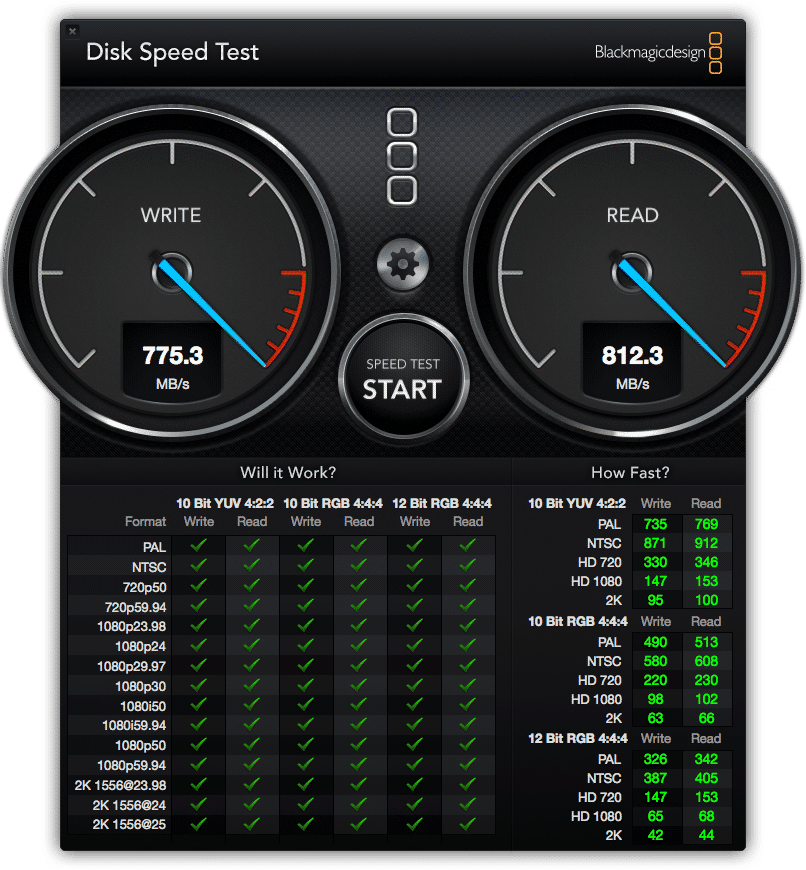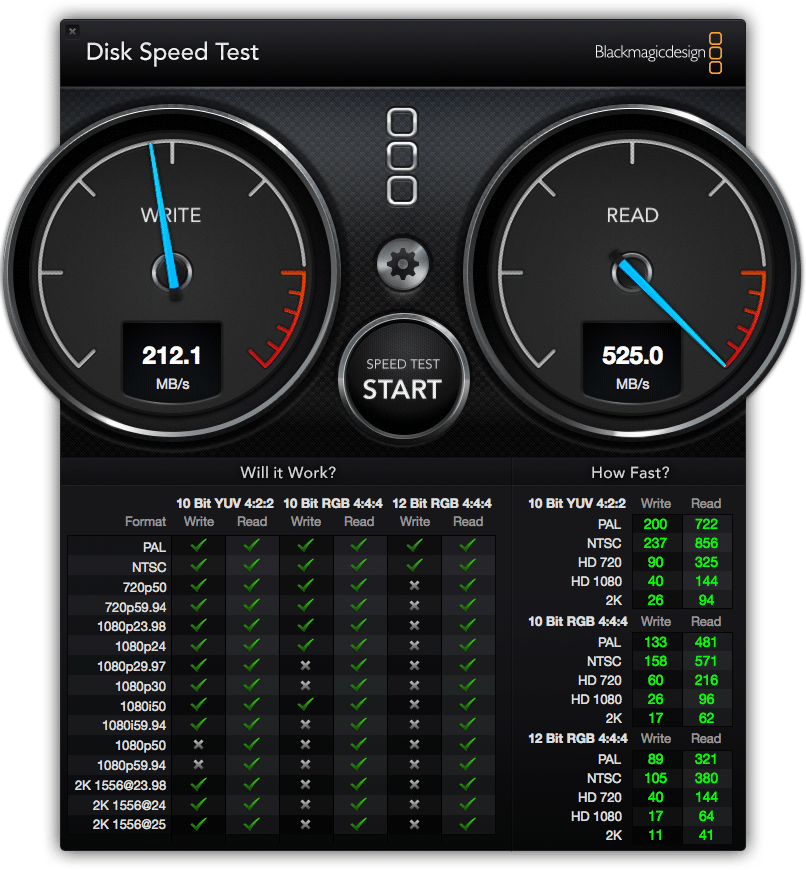The Blackmagic MultiDock is a 4-bay SSD dock that enables users to insert multiple SSDs from a production video camera and then edit files directly from a Thunderbolt enabled computer. The MultiDock installs quickly by using the drivers already installed on Thunderbolt enabled computers. Users can mount up to 4 2.5” SSDs by simply plugging them in and then the drives will be mounted to the computer the same as regular hard disks. The BlackMagic MultiDock is compatible with both Thunderbolt and Thunderbolt 2 connections on both PC and Mac platforms.

The Blackmagic MultiDock is ideal for photo and video professionals and enthusiasts. Large media files that are recorded directly to an SSD through cameras, such as Blackmagic’s Production Camera 4K, can be edited right on the SSD by simply plugging it into the dock. Since the MultiDock supports up to 4 SSDs, user can have all of the media mounted at the same time for editing. The Thunderbolt 2 connection allows for enough bandwidth to handle Ultra HD, 4K, and 3D stereoscopic files. The MultiDock can also be used as a multi disk array with RAID support that can reach speeds over 500MB/s.
Blackmagic MultiDock has a price of $595 and comes with a 1-year limited warranty.
Blackmagic Multi Dock specifications:
- Form factor: 1U
- SSD interface: 4 x 2.5″ SATA 3 6Gb/s
- Computer interface: 2 x Thunderbolt
- Operating systems:
- Mac OS X 10.9 Mavericks, Mac OS X 10.10 Yosemite or later
- Windows 7 or Windows 8
- Power requirements: 1 x IEC Power connection supports 110v – 240v.
- Environmental:
- Operating Temperature: 5 to 50º C (41º to 122º F)
- Storage Temperature: -20 to 45º C (-4º to 113º F)
- Relative humidity: 0% to 90% non-condensing
- Dimensions (HxWxD): 1.75 x 18.98 x 5.82 in
- Weight: 4.25 lbs
- Warranty 12-month limited
Design and build
The Blackmagic MultiDock is a 1U rack mount device. It has no software so it is entirely a plug and play device. The front of the device has a dark gray metal face plate with branding on the left hand side and the 4 dock bays running across the center. Around each dock there is a disk access indicator that lights up red letting users know which drive is in use.

The sides of the device have passive ventilation, in fact it is the only ventilation that can be found. Going around to the rear of the device the power connection is on the left hand side while the 2 Thunderbolt connections are on the right. Overall the unit feels very well built with rack mounting ears that are structurally sound.
Testing
For this review we tested the Blackmagic MultiDock on a current generation MacBook Pro using 4 256GB Samsung 850 PRO SSDs and using the Blackmagic Speed Test. We also tested the MultiDock on our consumer testing platform. This is a stand-alone review without competitive data, however the device itself doesn’t have much in the way of direct competition. We tested a single drive, RAID mirror, and RAID0 configuration.
When testing the MultiDock in RAID0, we saw read and write speeds of 812.3MB/s and 775.3MB/s respectively. This is much higher than the claim of 500MB/s (though Blackmagic didn’t assign a configuration with the claim). Obviously RAID0 gives the best performance but not the best data protection. In the event of a failure the work for the given session could be lost, however the core data would be retained located on a secondary storage system.

Testing the device on RAID mirror, we see a dip in performance but that is to be expected with increase in data protection. We saw a read speed of 525MB/s and a write speed of 212.1MB/s.

We also tested a single drive which gave us a read speed of 383MB/s and a write speed of 357.7MB/s

Testing the MultiDock on our consumer testing platform, with a 2MB sequential test a single drive showed us speeds of 330.97MB/s write and 362.16MB/s read. On the 2MB random test we saw speeds of 308.62MB/s write and 358.92MB/s read. On a smaller 4K random test we saw speeds of 38.39MB/s write and 20.22MB/s read. Running four drives in aggregate, with a 2MB sequential test the drives showed us speeds of 849.11MB/s write and 889.4MB/s read. On the 2MB random test we saw speeds of 847.31MB/s write and 890.02MB/s read. On a smaller 4K random test we saw speeds of 101.79MB/s write and 72.33MB/s read.
Conclusion
The Blackmagic MultiDock is an SSD dock that enables users to insert up to 4 2.5” SSD and edit the content right on the drive without copying the files over. The MultiDock is compatible with most editing software and has no software of its own making it very easy to deploy. The device connects to the user’s computer through Thunderbolt 2 connection giving it enough bandwidth to transfer large files such as 4K video files. The MultiDock can also be used as a direct attached SSD storage array. Again no software is needed, the device just has to be configured through the disk utility for RAID configuration.
Looking at testing, we tested the Blackmagic MultiDock on a current generation MacBook Pro using the Blackmagic speed test and on our PC consumer testing platform. The device claimed RAID speeds greater than 500MB/s and was above that speed in both the RAID0 and RAID mirror test. With RAID0 we saw read speeds of 812.3MB/s and write speeds of 775.3MB/s. RAID mirror also went above the claim with a read speed of 525MB/s, the write speed was 212.1MB/s. We also saw speeds of random and sequential speeds on our consumer testing platform around 900MB/s. These speeds should give the editing professional what they need to do most editing jobs.
Pros
- No software to install
- Quick setup
- Ability to edit without copying files off the storage medium
- Very well built
Cons
- Would be nice to top 1GB/s throughput which the SSDs are capable of
The Bottom Line
Blackmagic’s MultiDock allows users to take SSDs straight from their camera, dock them, and then edit directly without copying files to a notebook or other storage. The MultiDock can also be leveraged as a multi disk SSD array for production scratch space adding to its flexibility.




 Amazon
Amazon